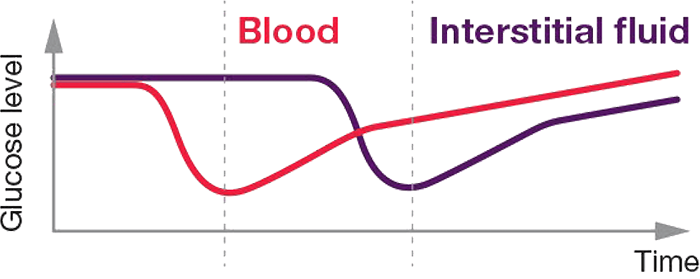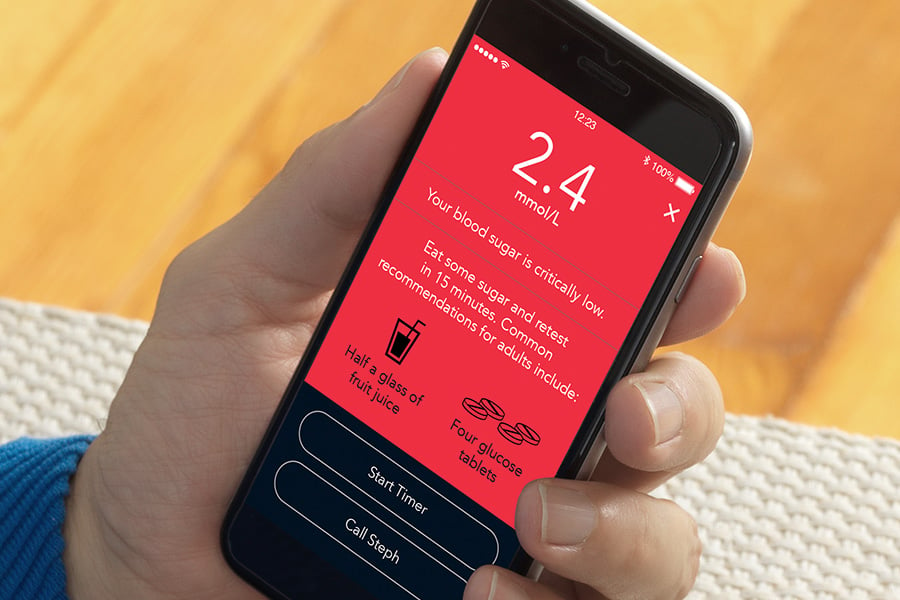Use CGM and BGM together to more confidently manage your diabetes
Continuous glucose monitoring (CGM) can be a convenient way to monitor your glucose levels. However, experts, leading organisations and many manufacturers who make CGM systems, agree that anyone using CGM should also have access to a blood glucose monitor (BGM) for safe and effective diabetes management.1–5

Before meals to give you a chance to adjust the meal insulin dose

If there are concerns that CGM readings do not reflect your blood glucose

To detect hypoglycaemia in situations, such as:
- before bedtime
- before driving
- before, during, and after exercise and
- when hypoglycaemic symptoms occur
Understanding your glucose monitoring options
People living with diabetes, especially those on insulin therapy, need to regularly check their blood glucose levels. There are different types of glucose monitoring systems available for people with diabetes:
How are BGM and CGM different?
Time Delay
CGM measures glucose in interstitial fluid, which lags behind blood glucose by 5 to 10 minutes. This delay means CGM readings may not reflect your current blood sugar level, especially during rapid changes (exercises, after meals).6

Accuracy Issues
CGM accuracy can vary due to physical activity, hydration, and other daily factors. That’s why CGM manufacturers and Australia diabetes management guidelines recommend using BGM for confirmation1–6. ISO 15197:2013 standards require ≥95% of BGM readings to fall within ±0.83 mmol/L or ±15% of reference values, depending on glucose concentration.7,8
When should you use a blood glucose meter?
There are key situations where BGM is essential:

Before driving or operating machinery
Always check your blood glucose before driving or handling heavy machinery. Blood glucose readings below 5.0 mmol/L can slow reactions and affect decision-making.6 Don’t Drive Under Five – your safety depends on it.9
When your CGM isn’t working
If your CGM sensor falls off, stops working, or you're taking a CGM holiday, use BGM as a backup. This ensures you can manage unexpected situations with confidence.


When you suspect low or high blood sugar
If you feel symptoms of hypoglycaemia (low blood sugar) or hyperglycaemia (high blood sugar), or are recovering from an episode, checking your blood glucose helps you take action quickly.6
When symptoms don’t match CGM readings
If your symptoms don’t match what your CGM is showing, double-check with a BGM to ensure accurate readings and make informed diabetes management decisions.6

Important message for those who are pregnant
If you are pregnant, BGM is strongly recommended if you have pre-existing diabetes or develop a form of diabetes during pregnancy known as gestational diabetes mellitus, to achieve your target blood glucose levels.10
Ask your healthcare provider about the target ranges you should be aiming for.11

^ Terms and conditions apply: Upgrades to CONTOUR®NEXT are limited to one (1) per NDSS registrant in an 18-month period. Requests for more than one meter in this period may not be accepted at the sole discretion of Ascensia Diabetes Care. Please contact our local customer service team on 1800 289 312 if you have a request outside of these guidelines.
* Minimum accuracy requirements of ISO15197: 2013 Section 6.3 standard require ≥95% of the measured values to fall within ±0.83 mmol/L at glucose concentrations<5.5 mmol/L or within ±15% at glucose concentrations ≥5.5 mmol/L compared to the reference method.
† An ad hoc analysis demonstrated that 95% of the results were within the error range ±0.3 mmol/L or ±5.3% of the laboratory reference values for glucose concentrations <5.5 mmol/L or ≥5.5 mmol/L, respectively.
1. American Diabetes Association 7. Diabetes Technology: Standards of Care in Diabetes—2024. Diabetes Care 2024; 47(Supplement_1):S126–S144.
2. Medtronic Guardian Sensor User Guide. M983403A011_A.
3. Abbott FreeStyle Libre 2 Plus. Your Complete Guide to FreeStyle Libre 2 Plus: https://www.freestylelibre.com.au/media/australialibre/Complete_Guide_to_FreeStyle_Libre_2_Plus_ADC-96942-V1.0.pdf. Accessed May 2025
4. Dexcom G6 User Guide. LBL018080 Rev 005 MT26356 Rev Date: 2023/10
5. Dexcom G7 User Guide. AW-1000103-01 Rev 001 Rev Date: 2024/06
6. Diabetes Australia: Blood Glucose Monitoring https://www.diabetesaustralia.com.au/managing-diabetes/blood-glucose-monitoring/ | Diabetes Australia. Accessed September 2025.
7. Pleus S et al. User Performance Evaluation and System Accuracy Assessment of Four Blood Glucose Monitoring Systems With Color Coding of Measurement Results. Journal of Diabetes Science and Technology 1-9, 2022.
8. International Organization for Standardization. In vitro diagnostic test systems - requirements for blood-glucose monitoring systems for self-testing in managing diabetes mellitus (ISO 15197). International Organization for Standardization, Geneva, Switzerland, 2013.
9. National Diabetes Services Scheme: Don’t Drive Under Five https://www.ndss.com.au/wp-content/uploads/diabetes-and-driving-quick-guide.pdf. Accessed September 2025.
10. Diabetes Australia: Managing gestational diabetes https://www.diabetesaustralia.com.au/managing-diabetes/gestational/ | Diabetes Australia. Accessed September 2025 11. DISCLAIMER: THE CONTENTS ON THIS WEBSITE DOES NOT PROVIDE MEDICAL ADVICE. The information, including but not limited to, text, graphics, images and other material contained on this website are for informational purposes only. No material on this site is intended to be a substitute for professional medical advice, diagnosis or treatment. Always seek the advice from your healthcare provider with any questions regarding medical condition, treatment choices and medical devices.



